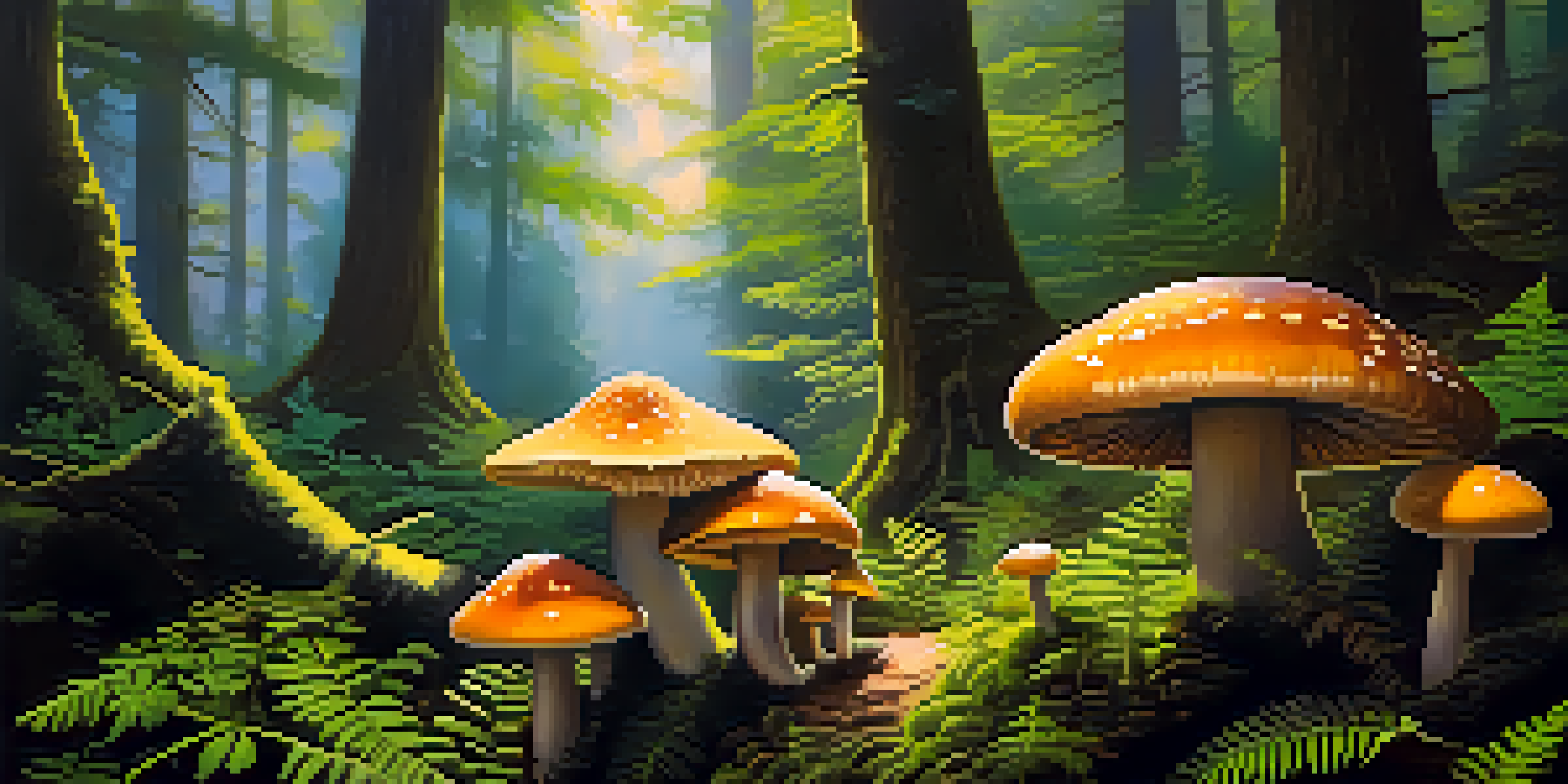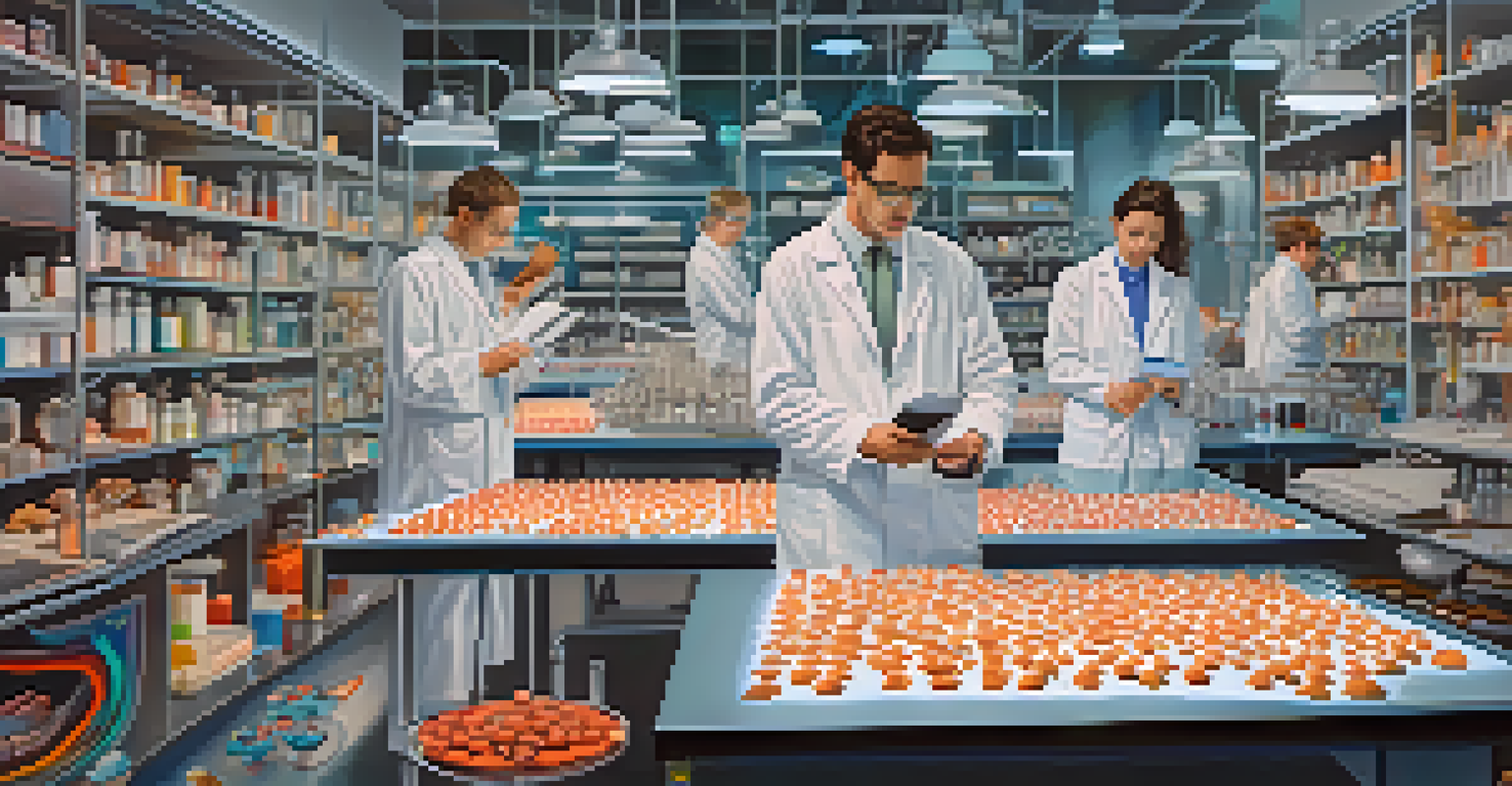A Comparative Study of Shrooms and LSD in Modern Therapy

Understanding Shrooms: A Brief Overview
Shrooms, or psilocybin mushrooms, have been used for centuries in various cultures for spiritual and therapeutic purposes. Their psychoactive compound, psilocybin, is known to induce altered states of consciousness, often leading to profound experiences. Recently, researchers have begun exploring these effects in clinical settings, particularly for mental health issues like depression and anxiety.
Psychedelics are not a panacea, but they can be a powerful tool for many people seeking to heal and understand themselves better.
The current wave of interest in shrooms reflects a broader trend towards considering natural substances in therapy. Studies show that psilocybin can help reset neural pathways associated with mood disorders, offering hope to those who may not respond to traditional treatments. As more evidence emerges, the potential for integrating shrooms into modern therapeutic practices becomes increasingly plausible.
However, it's essential to approach shrooms with caution. While the benefits are promising, the experience can vary widely among individuals, and there are risks of adverse reactions. This duality of potential benefits and risks is a common theme when comparing shrooms to other psychedelics like LSD.
LSD: A Historical Perspective on Its Use
Lysergic acid diethylamide, commonly known as LSD, has a storied history that dates back to its synthesis in the 1930s. Initially researched for its potential in psychotherapy, LSD gained notoriety in the 1960s counterculture movement before being classified as a Schedule I substance. Recently, however, there has been a resurgence of interest in using LSD for therapeutic purposes, particularly in treating PTSD and anxiety.

Research indicates that LSD can help facilitate introspection and enhance emotional processing, making it a valuable tool in therapeutic settings. The drug's effects often lead to significant personal insights, and when combined with guided therapy, many users report lasting positive changes in their mental health. This contrasts with traditional medications that often focus solely on symptom management.
Shrooms and LSD Show Therapeutic Promise
Research indicates that both shrooms and LSD can offer significant mental health benefits, particularly for conditions like depression and anxiety.
Despite its therapeutic potential, LSD also carries its own set of risks and challenges. The unpredictability of its effects can lead to difficult experiences, and like shrooms, careful consideration and professional guidance are crucial in its use for therapy.
Comparing Mechanisms: How Shrooms and LSD Work
At a fundamental level, both shrooms and LSD act on the brain's serotonin receptors, particularly the 5-HT2A receptor. This interaction can lead to altered perceptions, mood changes, and enhanced emotional processing. However, the duration and intensity of their effects can differ significantly, with shrooms typically lasting 4-6 hours and LSD around 8-12 hours.
The use of psychedelics in therapy is not just about getting high; it’s about creating a safe space for people to explore their inner landscapes.
The subjective experiences also vary; shrooms tend to create a more organic, earthy sensation, while LSD is often described as more synthetic and stimulating. These distinctions can influence the therapeutic setting, as practitioners may choose one over the other based on the desired outcomes and the individual's preferences. Understanding these nuances is vital for effective treatment planning.
Additionally, the two substances can yield different therapeutic benefits. While both can promote introspection, shrooms are often linked to emotional breakthroughs, whereas LSD may enhance cognitive flexibility. This makes it essential for therapists to consider the unique qualities of each when determining the best approach for their clients.
Therapeutic Applications: Current Research Insights
Recent studies have highlighted the therapeutic potential of both shrooms and LSD in various mental health contexts. For instance, clinical trials have shown that psilocybin can significantly reduce depression symptoms in treatment-resistant patients. Similarly, LSD has demonstrated efficacy in alleviating anxiety for those facing terminal illness, helping them cope with their circumstances.
These findings are part of a larger movement advocating for the re-evaluation of psychedelic substances in medicine. As researchers continue to investigate their effects, we may find that these compounds can offer solutions where conventional therapies fall short. The growing body of evidence is encouraging, but more rigorous studies are needed to fully understand their potential.
Caution Needed in Psychedelic Use
While promising, the use of shrooms and LSD carries risks, highlighting the importance of professional guidance and safe therapeutic settings.
Moreover, the therapeutic settings in which these substances are administered play a crucial role in their effectiveness. Guided sessions with trained professionals can help individuals navigate their experiences and integrate insights, maximizing the therapeutic benefits of both shrooms and LSD.
Legal and Ethical Considerations in Therapy
The legal landscape surrounding shrooms and LSD is complex and varies widely across different regions. While some areas have begun decriminalizing or legalizing psilocybin for therapeutic use, LSD remains a Schedule I substance in many places. This discrepancy poses significant challenges for researchers and therapists seeking to explore these substances in clinical settings.
Ethical considerations also come into play, particularly regarding informed consent and the safety of participants. Therapists must ensure that clients are fully aware of what to expect and the potential risks involved. Establishing a clear framework for the responsible use of these substances is essential for ensuring patient safety and maximizing therapeutic outcomes.
As the dialogue around psychedelics continues to evolve, it’s crucial for practitioners to stay informed about legal changes and ethical guidelines. This will help them navigate the complexities of integrating shrooms and LSD into modern therapeutic practices while prioritizing client welfare.
Personal Experiences: Anecdotes from Users
Many individuals who have tried shrooms and LSD for therapeutic purposes share transformative experiences. Users often recount moments of deep introspection, emotional release, and newfound perspectives on their lives. These anecdotes serve as powerful testimonials to the potential benefits of these substances in a controlled, therapeutic environment.
For instance, one user described a psilocybin session that allowed them to confront unresolved grief, leading to profound healing. Another individual shared how an LSD experience helped them break free from negative thought patterns, enabling them to approach life with renewed optimism. Such stories highlight the human capacity for growth and healing through these unique experiences.
Legal Landscape Remains Complex
The legal status of shrooms and LSD varies widely, affecting their accessibility and the ability to incorporate them into therapeutic practices.
While personal experiences can vary significantly, they underscore the importance of guided sessions and the therapeutic context in which these substances are used. The right environment and support can make a world of difference, turning a potentially overwhelming experience into a beneficial one.
The Future of Shrooms and LSD in Therapy
As research continues to unfold, the future of shrooms and LSD in therapy looks promising. With more studies demonstrating their efficacy, we may soon see these substances becoming integrated into mainstream mental health treatment. This shift could revolutionize how we approach mental health, moving away from solely pharmaceutical solutions.
Furthermore, as societal perceptions of these substances evolve, public acceptance may pave the way for broader access to psychedelic therapies. Initiatives advocating for decriminalization and therapeutic use are gaining traction, encouraging more people to explore the potential benefits of shrooms and LSD under professional guidance.

However, caution remains essential. As interest grows, it’s crucial to establish robust frameworks for research and therapy that prioritize safety and ethical considerations. The continued dialogue around shrooms and LSD will shape their role in the future of mental health care, potentially offering new pathways for healing and understanding.